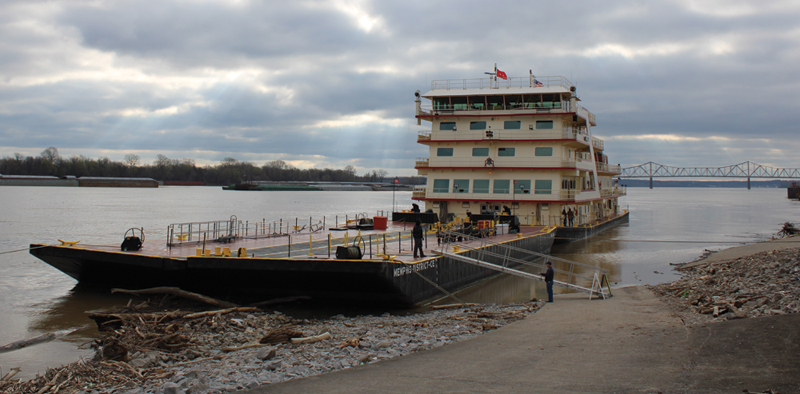Standing aboard the mv. Mississippi for the Mississippi River Commission’s annual high-water inspection trip March 27, Maj. Gen. Diana Holland said this trip would be her last aboard the vessel.
Holland is retiring from the Army after 33 years of service and roughly 18 different assignments, including the past three years as commander of the Mississippi Valley Engineer Division, a position that also entails serving as president of the commission.
“This has truly been a highlight,” she said moments after adjourning from the commission’s public meeting in Cairo, Ill., the first of four meetings planned on the trip. “I feel like I am going out on a high note.”
Brig. Gen. Kimberly Peeples, commander of the Great Lakes and Ohio River Division since 2021, will take over command of the Mississippi Valley Division in a ceremony July 12 in Vicksburg, Miss. She is already serving as a Mississippi River Commission member, so she is familiar with its mission to provide water resources engineering direction and policy advice to the president, Congress and the Army. The seven-member commission is presidentially appointed and has been in existence since 1879.
Peeples will hand over command of the Great Lakes and Ohio River Division to Brig. Gen. Marc Quander in a ceremony in late June in the Cincinnati area, according to Jacqueline Y. Tate, public affairs director for the division. Quander currently serves as the 79th commandant of the U.S. Corps of Cadets at the U.S. Military Academy at West Point in New York.
Holland also introduced one new commission member, Robert Miller, who replaced Norma Jean Mattei as her tenure ended. Miller is an assistant professor at the University of Louisiana-Lafayette and assistant director at the Watershed Flood Center.
When the floor opened up for the audience to address the commission, 13 registered speakers variously made requests of the commission, gave thanks for past work accomplished or made their concerns known.
Cairo Mayor Thomas Simpson spoke about the poor condition of the city’s floodwall, which the commission planned to tour.
Madison Baker, speaking for Missouri 8th District Rep. Jason Smith, said the congressman was concerned to hear that the Corps of Engineers doesn’t plan to take on more projects using the Inland Waterway Trust Fund because of having so many other ongoing projects.
Greg Curlin, executive director of the Hickman-Fulton Riverport Authority in far western Kentucky, said his port was shut down for eight days during low water even though the adjacent river was open because it was too shallow to accommodate barges that required an 8-foot draft, even with recent dredging.
“It happened at the worst time, the middle of harvest season,” Curlin said.
Cary Harbison, executive director of the Southeast Missouri Regional Port Authority, thanked the commission for recent dredging but stressed that small ports need to know farther in advance if regular dredging will continue instead of waiting each year to find out how much money the Corps has available for dredging and which harbors will be included.
“These harbors are the lifeblood of their communities,” he said in explaining their importance for jobs and overall commerce.
‘Historic’ Funding
Holland spent part of the meeting highlighting the Mississippi Valley Division’s accomplishments over the past year.

She noted that the year had brought with it record levels of appropriations, which came on the heels of the Infrastructure Investment and Jobs Act and the Disaster Relief Supplemental Appropriations (DRSA) funds received after two hurricanes hit Louisiana in fall 2021. She highlighted the Mississippi River and Tributaries Project, which received $1.3 billion for repairs and continued work on the system.
“We are turning dirt as we speak,” she said of work beginning on many projects. She highlighted the importance of several projects that have interconnected effects on the system, including construction at the Brandon Road Lock and Dam on the Illinois River that is designed to prevent the spread of invasive species into Lake Michigan and the Navigation Ecosystem and Sustainability Program (NESP), which received full funding for construction of a new 1,200-foot lock at Upper Mississippi Lock 25, the first of seven locks being either enhanced or rehabilitated as part of that project.
Additionally, she said the Corps received historic levels of funding for operations and maintenance.
“So 2022 was a big year, and I just want to thank everybody here in this room, those who couldn’t be here today and our congressional delegation that made that funding possible,” she said.
Looking ahead, Holland pointed out that the fiscal year 2023 president’s budget is for $228 million; that the fiscal year 2023 Corps of Engineers Work Plan is for $141 million; and that the fiscal year 2024 president’s budget is for $230 million, for a total of an additional $600 million.
“So the investment continues, and we just feel very honored that you trust us, our Congress trusts us to make improvements along the Mississippi River and for those who live and work alongside of it.”
Recent Low-Water Event
Much of Holland’s comments focused on the record low water that began in September 2022. The last comparable low-water event before that was in 2012.
“When they happen, they may not happen very frequently, but they are incredibly consequential, as you all know,” she said.
In fighting this low-water event, she said it was important to remember what worked in 2012 and to make sure the Corps had incorporated best practices.
“We don’t just maintain the river,” she said. “We continue to engineer the river, and that’s really what got us through this recent low-water event of 2022-2023.”
Engineering Improvements
Since 2012, Congress has invested $1.5 billion in the Mississippi River and Tributaries Project in channel improvement and $55 million in regulating works pertaining to the middle reach of the Mississippi River, between its confluence with the Missouri River and its confluence with the Ohio River.
The channel improvement program prevents erosion along the riverbanks. The regulating works program includes building additional training structures, such as chevrons and weirs, in the river that channelize it and help naturally scour the river and remove sediment so that not as much dredging is required to maintain the depth of the navigational channel. Those structures are especially important because they help to create less risk and vulnerability “and fewer restrictions to navigation, which is vitally important,” Holland said.
One example she pointed out was the removal of rock pinnacles in the Mississippi River near Thebes, Ill., that caused a navigation hazard in 2012. While the river was low that year, the Corps removed 1,000 cubic yards of rock formation, which deepened the river 2 to 3 feet in the area, “making the rock pinnacles really a non-issue for us this year,” she said.
Another lesson learned and put into practice this year was the creation of a saltwater sill below New Orleans, 50 feet in elevation from the river bottom but with its top below the surface of the water deep enough that it did not impact navigation. That sill, built by contractors with the New Orleans district, protected more populated municipal freshwater intakes by preventing the intrusion of denser saltwater northward from the Gulf of Mexico as the flow of the Mississippi dropped and was not as forceful. The sill is designed to gradually erode over time without any further effort by the Corps, Holland said. She called it a “really powerful tool.”
Continuing The Work
With better research and development and better modeling and a better understanding of where shoaling is most likely to occur, the Corps maintains flow while dredging far less than it did during its peak in the 1960s, when it dredged 60 million cubic yards of sediment, she said.
“It was at that point that some smart people realized we need to continue to engineer the river because it’s becoming prohibitively expensive, and it’s consuming all our resources,” Holland said. “Hence was born the program to build the dikes and weirs and chevrons and other features that would naturally scour the river so we didn’t have to do so much of it.”
Most of the dredging from the fall 2022 event was captured in data for the 2023 fiscal year, which began October 1, 2022, with 20 million cubic yards of sediment removed, Holland said.
Col. Brian D. Sawser, Memphis District commander, also emphasized the importance of continuing to engineer the river in his presentation to the audience. He displayed a graph comparing the Memphis, Tenn., record low water stage in 2022 as negative 10.8 feet with a flow of 140,000 cubic feet per second (cfs). In 1988, the low water level was remarkably similar, at negative 10.7 feet, but at that time the flow was only 113,000 cfs, he said. Even in 2012, when the gauge at Memphis was at negative 9.8 feet, the flow was barely more than in 2022, at 147,000 cfs. The difference is the engineering work that has continued to be accomplished along the river by the Corps and its contractors, he said.
Still, both Holland and Hawser were quick to say that didn’t mean that dredging had not been vital during the low water.
Investing In Dredging
“Dredging is never going to go away, but our efficiency has gone up,” Sawser said.
Holland offered a “shout out” to dredge crews, calling them heroes. At one time, 13 government and contracted dredges were working along the river during the low-water event, she said.
“It was a daily firefight to respond to the various points of friction,” she said.
Many of these dredges contracted with the Corps, as the Corps of Engineers has only three dustpan dredges of its own, with two of them 90 or more years old.
“The red flag that I continue to communicate to the USACE headquarters and our Congressional delegation is that if the pattern continues and we have another low-water event like we had, 10 years from now, those two dustpans will be 100 years old,” Holland said. “Our team will continue to work hard to keep them running, but of course every year that goes by without recapitalization or replacement, we are at risk.”
Looking For The Positive
One positive that came out of the low-water event is that for a while the rivers had the nation’s attention, which could help to ensure future funding, even though the low water also came with enormous challenges to the economy, commodities, farmers and small ports and harbors, Holland said.
“We did keep the river open,” she said. “That is our job every day, to keep this river open and safe, but at a huge cost. It cost $50 million for the Corps to keep the river open. Just for context, that’s more than a year’s worth of normal dredging, so we had to be reimbursed to allow us to get through the rest of the year. Congress was very generous and understood the importance of it, and we did get that reimbursement.”
Looking forward, she said, there is still much work that needs done, continuing to engineer the river. The Corps has calculated that it will take another $2.3 billion in investment into the Mississippi Rivers and Tributaries Project for the river to pass the project design flood.
“That doesn’t mean that the project is complete, but that would solve all the critical items,” Holland said.
She stressed that the Mississippi River and Tributaries Project continues to have a 131-to-1 return on investment, which she called extraordinary and unmatched anywhere.




